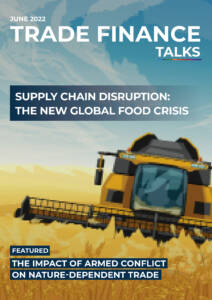We currently live in uncertain times, both geopolitically, and from a macroeconomic perspective. TFG asked two risk management experts for their take on how businesses can navigate through this period of economic volatility.
One of the main questions on everybody’s mind right now is how to manage risk, particularly when it comes to supply chains, logistics, and freight forwarding.
According to Rod Hutchinson, regional business development manager (Americas) at Veridapt, for many businesses, it’s not so much about de-risking as a need for better forward planning, inventory management, and increased liquidity:
“It’s really about how we are working together to bring better risk management solutions to the market,” Hutchinson said.
“But in terms of challenges in the supply chain and longer-term effects on liquidity, we’ve seen a lot of financiers de-risking – getting out of the market when there’s really been an increased need for liquidity.
“There’s a move away from ‘just in time’ to ‘just in case’, which means companies are holding more inventory on their balance sheet for longer, and therefore need more working capital.”
On the trade side, there is also a greater need to monitor the physical flow of goods within the supply chain to eradicate things like theft and fraud and to make sure businesses have access to more liquidity so as to compensate for soaring commodity prices.
The problem of fraud and how to deal with it
Indeed, fraud and a lack of clear rules about how to handle it is a historical problem within the international trade and export sector that needs to be addressed. According to Peter Hopkins, CEO of DrumRisk, 2020 was a turning point for the industry in many respects.
“If we go back 25 years, we would have been mandated by the big trade companies in the industry, which meant that the rules were clear – everybody knew what they were getting and there was tight monitoring in terms of what was being provided,” Hopkins said.
“Where we are now is that we’re working for international lenders and financiers, but it’s the borrower who pays and so, over the last 15 years, there’s been a race to the bottom, which unfortunately has now come home to roost.
“Unless we create a more professional service and bring in more technical expertise, we’re going to be seeing more and more fraud events happening.”
Both leaders felt that technical solutions like real-time inventory monitoring and digital stock management could also help lower the risk of theft and streamline the export-import process considerably.
This would help remove the burden of businesses or regulators having to hire extra manpower at a time when many firms are already struggling financially.

The limits of technology – still very much a need for the human element
However, Hopkins was quick to add that in some instances, you can’t replace human beings – they still remain critical to the smooth functioning of risk management, security, and safety processes within the entire supply chain.
“The human being is there to prevent the unplanned, unforeseen, and also the corrupt elements, so our key purpose is to actually have a physical presence – to be there to physically monitor certain control points so that ultimately, we can provide the lender with a declaration they can use,” Hopkins said.
When combined with technology, which can be used to test, track, and monitor goods in transit, it provides insurance underwriters and lenders with verifiable assurance.
“It’s a brilliant system of checks and balances for our personnel and it’s therefore double reporting to a lender.”
Rod Hutchinson added that technology like LiDAR lasers can also be used in a similar way to make operational processes like stockpile monitoring and collateral or inventory management more efficient.
Having access to real-time, independent information that links the physical to the digital can help with things like order flow and bring additional peace of mind for security managers, as well as finance directors and financiers.
Joining up the Physical and Digital Domains: Use case for Blockchain Technology
When asked about the use case for newer technologies like blockchain ledgers to help with verification and risk management, Hopkins is cautiously optimistic.
“Without being cynical, there’s an awful lot of effort and time being spent on the blockchain,” Hopkins said.
“The blockchain is a very tight financial documentation flow but unfortunately, at the moment, there is no real-time interface between the physical world and the blockchain.
“So we have these two completely different information streams – the operational is just not being mirrored into the blockchain developments.”
Hopkins added that discussions were underway behind the scenes over the last two to three years to develop platforms that could help organisations link up the physical world of goods with digital forms of financial documentation like blockchain.
This would help to create a very in-depth system of measurement and verification between the two worlds.
Going forward: Collaboration and education key
Overall, both experts felt that there needed to be more investment in technological solutions within the financial, commodity, and trade sectors to help streamline the supply chain and reduce risk.
It also had the potential to help companies track their carbon footprint more effectively so as to verify how sustainable their products and services actually were.
However, this is not likely to be an overnight process.
“So really this whole technology game is about collaboration, adoption of technologies, and applying the time, resources and the budgets on such technology, Hutchinson said.
Certainly, though, both agreed that education and a joined-up approach across sectors, rather than different industries operating in independent silos, all solving individual problems, was critical.
This would not just speed up adoption, but also serve as a way to provide an additional layer of assurance that could reduce risk and help everyone ride out the current storm of market turmoil and uncertainty with greater peace of mind.
Read the latest issue of Trade Finance Talks, June 2022






























